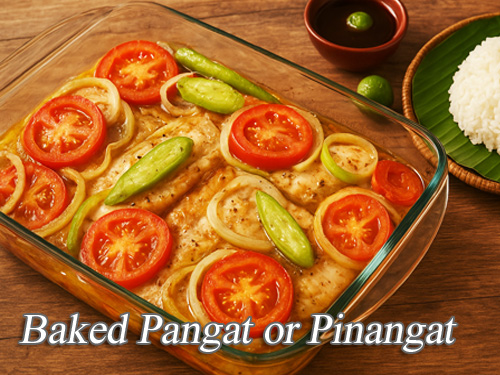How to Make Baked Pangat or Pinangat
Baked pangat is a Filipino-style fish dish made with fillets layered in tomatoes, onions, and tangy kamias, then slowly baked in olive oil until tender and flavorful.
Prep Time10 minutes mins
Cook Time45 minutes mins
Total Time55 minutes mins
Course: Fish Recipe
Cuisine: Filipino
Keyword: baked pangat, baked pinangat, fish fillet recipe, pinangat recipe, ulam ideas
Servings: 6 servings
Calories: 231kcal
Author: Manny
- 1 kilo lapu-lapu or maya-maya fillets
- 4 pcs big tomatoes sliced into rings
- 3 pcs big onions sliced into rings
- 6 pcs fresh kamias sliced into rings
- 1/2 cup olive oil
- 1 Tbsp. salt
- 1/4 tsp. peppercorns crushed
How to cook Baked Pangat or Pinangat
Line the bottom of a pyrex dish with sliced tomatoes, onions and kamias.
Pour in half of the olive oil and arrange a layer of fish fillet.
Sprinkle salt and pepper on both sides.
Add remaining tomatoes, onions and kamias on top of the fish fillets.
Sprinkle with salt and the remaining half of the olive oil.
Bake at 350 °F for 45 minutes or until fish is cooked.
Serve hot with steamed rice. Serves 6.
Cooking Tips:
Use Fresh Fish Fillets
Freshness is the secret to a flavorful baked pangat, so choose fillets that are firm, shiny, and have a mild ocean scent. Lapu-lapu and maya-maya are excellent options because they hold their shape well in the oven. Avoid frozen fillets if possible, as thawed fish can become mushy and affect the dish’s texture.
Don’t Skip the Kamias
Kamias is the heart of this dish, providing the signature tangy kick that balances the richness of olive oil and fish. If fresh kamias isn’t available, you can use green mango or calamansi, but the flavor won’t be quite the same. Including kamias keeps the dish true to its Filipino roots and makes every bite bright and refreshing.
Layer Ingredients Properly
Lining the bottom of the dish with tomatoes, onions, and kamias ensures the fish absorbs all the flavors as it bakes. Adding another layer on top creates a natural seal that keeps the fillets moist and juicy. This technique also allows the vegetables to slowly release their juices, forming a light sauce without needing extra broth. 